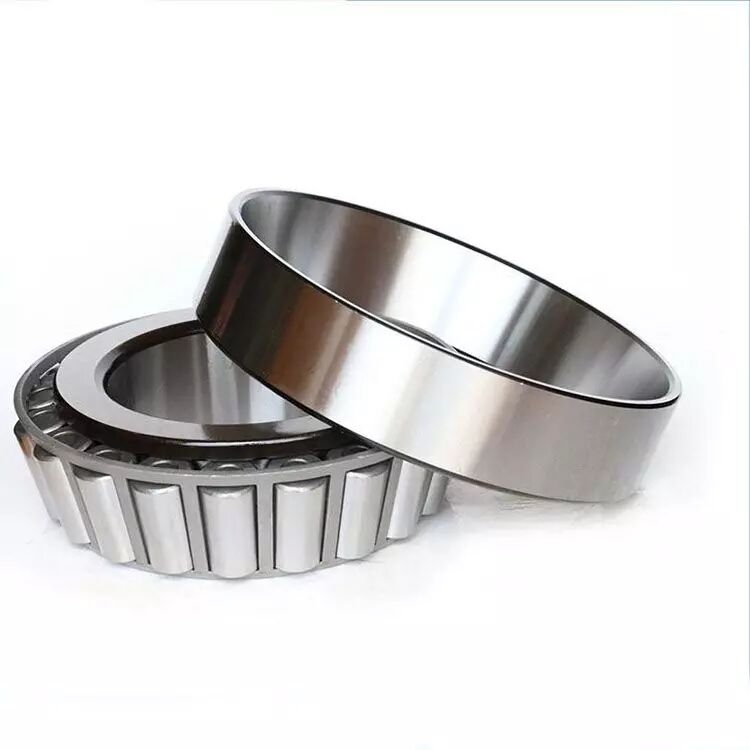The tapered roller bearing has a tapered inner ring and an outer ring raceway, and the tapered rollers are arranged between the two. All the projection lines of the cone surface converge at the same point on the bearing axis. This design makes tapered roller bearings particularly suitable for bearing compound (radial and axial) loads. The axial load capacity of the bearing is mostly determined by the contact angle α; the larger the angle α, the higher the axial load capacity, and the angle size is expressed by the calculation coefficient e; the larger the value of e, the greater the contact angle, and the bearing will bear The greater the applicability of the axial load.
Tapered roller bearings are usually separated, that is, the tapered inner ring assembly composed of the inner ring with roller and cage assembly can be installed separately from the tapered outer ring (outer ring).
Tapered roller bearings are widely used in industries such as automobiles, rolling mills, mining, metallurgy, and plastic machinery.
The secondary reason for the scars of the tapered roller bearing during the installation process is: the bearing is installed and assembled, the inner ring and the outer ring are skewed; or maybe the charge and the load in the installation and assembly process are trapped, which leads to the formation of the bearing scars. .
When the tapered roller bearing is being installed, it must be stopped in accordance with the working specifications. If there are many achievements, such as the form of the device or the improper method, it will form the raceway surface and the bone surface of the bearing to form linear scars on the bearing. The device of the deep groove ball bearing indirectly reflects the precision, life and function of the bearing in use.
Although the quality of tapered roller bearings and other aspects are relatively good, rolling bearings are precision parts, and their use must be carried out accordingly. No matter how high-performance bearings are used, if they are used improperly, the expected high performance will not be obtained. There are several precautions for the use of bearings:
(1) Keep the tapered roller bearing and its surroundings clean.
Even small dust invisible to the eyes can have a bad effect on the bearing. Therefore, keep the surroundings clean to prevent dust from entering the bearing.
(2) Use with caution.
A strong impact on the tapered roller bearing during use can cause scars and indentations, which can cause accidents. In severe cases, it will crack or break, so be careful.
(3) Use appropriate operating tools.
Avoid replacing with existing tools, you must use appropriate tools.
(4) Pay attention to the corrosion of tapered roller bearings.
When handling bearings, sweat on your hands can become a cause of rust. Be careful to operate with clean hands and try to wear gloves.
It is a very common method for tapered roller bearings to use hearing to identify irregular operation. For example, it is used by experienced operators to detect abnormal noise of a certain part with the help of an electronic stethoscope. If the bearing is in good running condition, it will make a low whine sound, if it makes a sharp hissing sound, tapered roller bearing, squeaking sound and other irregular sounds, it usually indicates that the bearing is in bad running condition.
1. Corrosion of tile surface: Spectral analysis found that the concentration of non-ferrous metal elements is abnormal; there are many sub-micron wear particles of non-ferrous metal components in the iron spectrum; the moisture of lubricating oil exceeds the standard, and the acid value exceeds the standard.
2. Strain on the journal surface: there are iron-based cutting abrasive particles or black oxide particles in the iron spectrum, and there is a tempering color on the metal surface.
3. Corrosion of journal surface: Spectral analysis found that the concentration of iron is abnormal, there are many sub-micron particles of iron in the iron spectrum, and the moisture or acid value of lubricating oil exceeds the standard.
4. Surface strain: cutting abrasive grains are found in the iron spectrum, and the abrasive grains are composed of non-ferrous metals.
5. Fretting wear on the back of the tile: Spectral analysis found that the iron concentration is abnormal, there are many sub-micron wear particles of iron in the iron spectrum, and the moisture and acid value of the lubricating oil are abnormal.
Under the condition of liquid lubrication, the sliding surface is separated by lubricating oil without direct contact, and friction loss and surface wear can be greatly reduced. The oil film also has a certain vibration absorption capacity.
The sharp squeaking noise may be caused by improper lubrication. Inappropriate bearing clearance can also cause metallic noise. The dent on the track of the outer ring of the tapered roller bearing will cause vibration and cause a smooth and crisp sound. If it is caused by knocking scars during installation, it will also produce noise. This noise will vary with the speed of the bearing. If there is intermittent noise, it means that the rolling elements may be damaged. This sound of tapered roller bearings occurs when the damaged surface is rolled over. If there are pollutants in the bearing, it will often cause a hissing sound. Serious bearing damage will Produce irregular and loud noise.
Post time: Mar-22-2021

